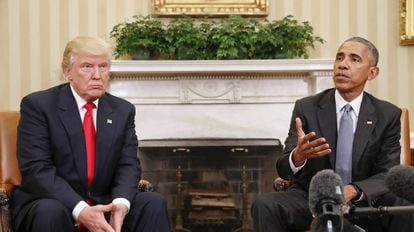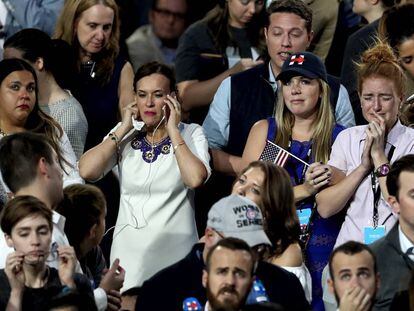Notes from an election
Trump didn’t win – it was Obama and the Clintons who lost
It’s all very recent. The data is still raw and it will take some time to make sense of this election. Thus, here are just a few points – hypotheses, doubts and questions. Certainties, which are few and far between, invite speculation and interpretation about the future. All of this said on “Monday,” moreover, with the stunner of the Sunday game known and the mistakes of the central defender repeated on TV ad infinitum.

The letter from FBI director Comey, about Hillary Clinton’s emails, changed the dynamic of the campaign just 11 days before the election and exacerbated her vulnerabilities in a way that perhaps had not been seen before. There was no time. As well as closing up the gap, that letter exposed her despair. So much, that the main response was to pull Obama fully into the spotlight of the campaign.
Even more than that, Obama shouldered the weight of the campaign, turning it into a personal issue, almost a referendum on his presidency. This was seen in the many party rallies in North Carolina, a state that he won in 2008 and lost in 2012 despite having staged the party convention in Charlotte, the most important city. Perhaps his own unsettled scores had come to the fore. It is unlikely that Trump is the only highly narcissistic politician.
Perhaps Obama’s own unsettled scores had come to the fore. It is unlikely that Trump is the only highly narcissistic politician
If the idea of a referendum was a mistake – a positive image and votes are rarely transferable from one politician to another, especially in presidential systems – the closing rally in Philadelphia on November 7 was virtually a political suicide – which is not the same as a virtual political suicide, given that it was very real. The stage was dominated by the Obamas, both more charismatic than Hillary Clinton, and by Bill Clinton, to whom, what’s more, they handed over the microphone. Double error: Bill Clinton has long been a political liability. Al Gore has known this since the year 2000.
By the time Hillary Clinton came on stage as the leading character, she had become supporting cast. And by that time, the audience was already saturated with so many presidents. Her candidacy ended up being presented as a third term, not of one but of two ex-presidents. The problem is that the third period has disappeared from US politics. Society rejects it, a piece of hard data that the pollsters – criticized without much basis today – have systematically shown.
The last third term was that of Reagan and George H. W. Bush in 1988. The majority of the electorate does not remember this episode or had not yet been born. All of a sudden the image of the Democrats was old. Sixteen years old, to be precise, which is bad news in an election. The word “change,” which holds immense electoral power, was the exclusive property of Trump.
The data are overwhelming; they need to be processed in order to get an accurate picture. Nonetheless, the pollsters didn’t get it as wrong as some are making out. On the morning of the election, they surprised us with a map that showed 15 tossup states – that’s to say, that could have gone either way. And they were right. It was unprecedented: the historical trend was five or six tossups. The path to victory for Clinton was wider than that of Trump, but also with a level of uncertainty three times higher than usual.
Bill Clinton has long been a political liability. Al Gore has known this since the year 2000
That suggests an election with a realignment, and it will have to be seen whether it lasts or has just been for 2016; namely, a realignment governed by volatility. We are starting to see an explanation, then, for the fact that Hillary Clinton has lost six million of Obama’s votes and Trump one million of Romney’s. The much talked about polarization didn’t happen; the Sanders voter seems to have stayed home on November 8. Apathy and abstention, instead, best capture what happened. In such scenarios the first vote to be lost is the “median voter,” the moderate who chooses centrist candidates.
Knowing the end of the story, the argument that Sanders could have beaten Trump makes sense. Those six million fewer votes need to be disaggregated on a district level. Because there also must be those from the unionized working class in the Midwest – historically Democrat – that would explain the result in Pennsylvania, Ohio, Michigan and Wisconsin, the so-called “blue wall.” In three of those the difference in favor of Trump was just 1%.
But these are just hypotheses. A Sanders nomination could also have activated the conservative electorate, causing the polarization that in the end did not occur. It’s a counterfactual, but it serves to debunk the myth of the Clinton electoral machine. Those who went out to protest against Trump’s election are probably angrier with their own party. Especially taking into account that in her concession speech Hillary Clinton made clear that she has no plans to go home.
The polarization that did happen, however, was the rural-urban divide, more prominent election after election. Look no further than the electoral map broken down by district, with blue dots on the coasts and from Chicago down the Mississippi valley, and red in the remainder of the country. Trump didn’t win in any city with more than a million inhabitants.
Thus, it wasn’t down to income nor employment, nor even inequality, given that wages keep on falling in cities as well as in the countryside. It’s better to turn to social status and cultural norms. It’s the country of the iPhone and Uber versus the country of the Smith & Wesson and the Ford F-150; the cosmopolitan country against nativism; the country of those who hold a passport – 48% of the population – versus those who do not have the slightest bit of interest in what goes on in the world. It’s like reading sociology of the 1960s: a dual country that is consolidated by modernization and the gap keeps widening today. Hard times for democracy.
The much talked about polarization didn’t happen; the Sanders voter seems to have stayed home on November 8
The image of the never-ending identity conflicts emerge from the exit polls: racism as the main explanatory variable. Perhaps another reason why the referendum on Obama was a bad idea. A world of contradictions in which 40% of women voted for Trump and Latinos reproduced the historical one-third Republican and two-thirds Democratic. An even greater “anomaly”: Trump got two percentage points more of the Latino vote than Romney did in 2012. All of this a far cry from the 75% predicted in favor of Clinton, and that would have given her the win. This is the debunking of several myths.
There will be a “Trump administration,” with its universe of uncertainties and the volatility of his personality. The world wonders whether he will impose tariffs on China, whether there will be reprisals and trade wars, and if this will cause investment to collapse. Additionally, Europe agonizes over the future of NATO. From the Baltic to the Balkans, post-communist Europe looks on with panic.
Latin Americans (and Canadians) fear for the future of NAFTA, as well as for the other five existing commercial agreements. Anti-immigrant xenophobia could reduce remittances, the main source of foreign exchange in many countries of the region; the majority of them, in fact. The Trump effect must also be added to the exhaustion of the super-cycle of commodities.
Within the United States it is plausible to think of a country like that of the 1960s, a divided society but one with a certain mirror image. That’s to say, in the 1960s the civil rights movement fought for its demands and radical students occupied university campuses in protest against the Vietnam war. Today the empowered are those opposed to immigration, with their racist and xenophobic reactions, while the American indignados, Sanders’ base, feel betrayed.
It is the democratic idea itself that is in crisis, and not just in the United States
The weather report is forecasting conflict, and conflict on the streets. The name of Giuliani in the Justice Department suggests a strong, rough state, a dose of McCarthyism mixed with J. Edgar Hoover – namely, an erosion of Constitutional rights and guarantees. Add to the recipe two, maybe three, new justices on the Supreme Court. To put it in terms of American constitutionalism, Andrew Jackson and the concentration of power have resoundingly defeated James Madison and the dispersion of power.
It is the democratic idea itself that is in crisis, and not just in the United States. This is not the first time – it also took place during the European interwar period, where it collapsed under fascism and communism, and it suffered in the 1970s, with the conservative response to the radicalization of the previous decade. Democracy is still alive but it’s far from healthy. It’s doing better than in the 1930s, but much worse than in the 1970s. The problem is that liberalism is in a deep coma, and without it there can be no democracy.
Buckle up! This will be a turbulent flight back to hard politics. The liberal internationalism of the 1990s was promising, but short-lived and a long time ago now. In fact, it happened in the previous century.












































